Below I will crunch the local housing price, sales volume, and inventory numbers to get an in-depth look at where the San Diego market stands and where it’s likely to go in the months ahead.
To start, it seems that the "mixed signals" I alluded to last month have resolved themselves. It turned out that my DataQuick sales data included many records of title changes that, while recorded with the county assessor, didn’t actually represent sales on the open housing market. These had always been there, but had represented a very small minority of the records. For some reason, the number of such "phantom sales" has surged of late, and this had the effect of overstating sales volume for the past several months. I have worked with DataQuick to filter out all phantom sales from past and future data, so we should now have a much "cleaner" picture of what’s going on.
The good news is that we now have a clearer picture as well. Last month I was hesitant to declare the housing market DOA because sales volume, often a good leading indicator for future price activity, seemed to be picking up. In fact, it was not picking up at all—it was declining, as the revised charts below will indicate. While bad for the housing market, it’s good for housing market analysts, because now there is no more apparent discrepancy between the housing indicators. All of them—inventory, prices, breadth, and now sales volume—are in agreement that the market has most probably begun its multi-year decline.
Enough talk… let’s crunch us some numbers.
Prices
The median price for both condos and SFRs dropped pretty sharply in the month of December:
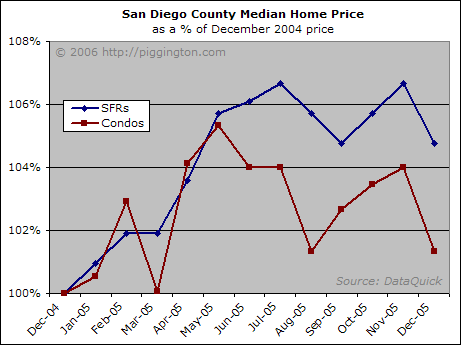
It’s important to keep seasonality in mind when looking at stats like this. There is a tendency for prices to moderate or even fall slightly near the end of the year, so the fact that prices are lower than they were in the summer doesn’t necessarily mean much by itself. This is why I emphasize the year-over-year values, which abstract out any seasonal variations.
Even by this measure, however, the price gains are fairly weak. The median condo price in San Diego county is now up just 1.3% from 12 months earlier. The median SFR is doing better, up almost 5% year-over-year, but when you consider that the agents will take 6% to sell your house, that 5% starts to look less impressive. The autumn rise in ARM rates is probably now feeding into slightly lower home prices.
The breadth indicators hint that the relative strength we’ve seen in the SFR market may be starting to wane:
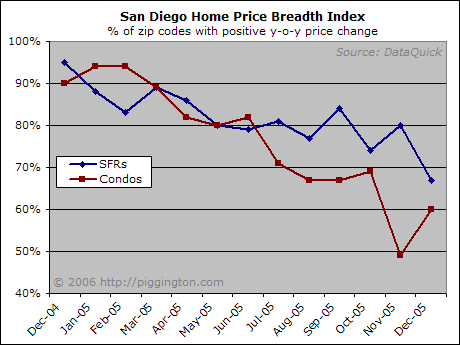
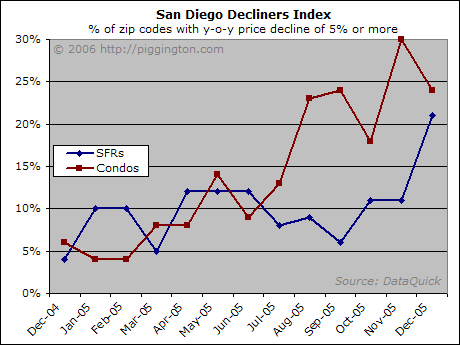
While condo breadth actually improved for the month, SFR breadth deteriorated. The Decliners Index is especially interesting—21% of San Diego zip codes saw their median SFR price decrease by 5% or more. This is double the amount of zip codes from just one month ago. It’s not a good idea to make a big deal of one month’s data, but it’s possible that we could be seeing the weakness that has plagued the condo market starting to spread to the (up until now) heartier SFR market in some zip codes.
Volume
As I mentioned above, volume was weak. SFRs and condos turned in their worst year-over-year comparison of 2005, down 27% and 29%, respectively:
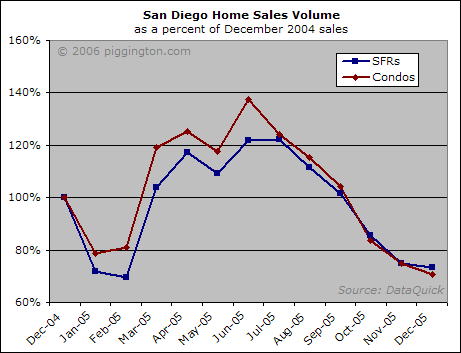
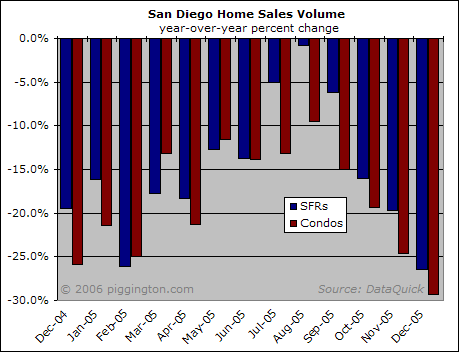
The new set of DataQuick data allows us to see that declining year-over-year sales comparisons were the theme for 2005. This represents a decline in housing demand, plain and simple, and it bodes quite poorly for the real estate market.
Inventory
The decline in sales is even more troubling considering the amount of inventory for sale. It appears that people took their homes off the market in December, and put them right back on the market after the holidays:
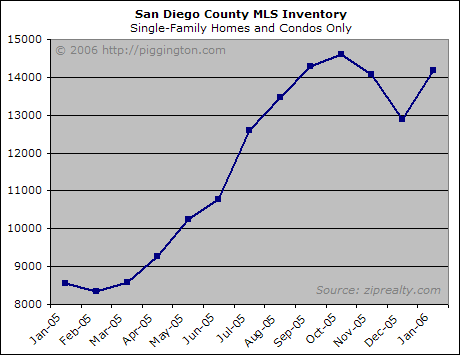
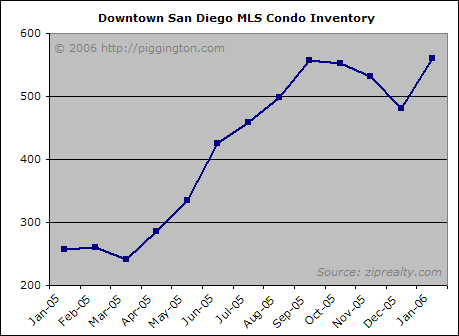
The growing disparity between supply and demand is interesting enough to warrant its own numerical measurement. For this new measure, I will compare current MLS inventories against the the number of sales during the most recent month. This measure will be skewed towards understating the number of months of inventory, because the inventory figures include only MLS-listed properties, whereas the sales figures include all sales regardless of whether the units were listed in the MLS. However, it should still be a useful gauge for tracking trends in supply and demand. Here are the figures for January 2006:
|
Property Type
|
Months of Inventory
|
|
SFR, SD County
|
4.8
|
|
Condo, SD County
|
8.8
|
|
Condo, Downtown SD
|
24.4
|
Despite potential price weakness forming, it seems that the supply/demand balance for SFRs is still not too terribly bad. This will likely support SFR prices in the months to come—although the new inventory onslaught expected over the next few months could change the equation. Condos are more abundant, but still within the realms of normalcy, at almost 9 months of inventory. Meanwhile, Craneville, USA is at official glut status with a shockingly high 2 years’ worth of inventory sitting on the MLS.
Conclusion
For the very short term, I think we are unlikely to see any big changes in housing market conditions, mostly due to the fact that mortgage market remains fairly well unchanged from last month. Further out, there are a couple of trends worth noting. One is that volume seems to be on an entrenched downhill slide. Another is that condo prices are damn near being flat year-over-year. Yet another is that pockets of San Diego have been experiencing falling condo prices, and may now have started to experience some falling SFR prices as well. And finally, there is just a lot of inventory out there for sale.
All of this points to poor performance by the housing market. It’s important to keep flexible, and to be open to the possibility that rates could drop or lenders could loosen standards even more, thus giving the market some support. But barring some serious help from the mortgage arena, it looks like those negative year-over-year comparisons may be coming soon. Until I see some evidence to the contrary, I continue to believe that the great decline has begun.
